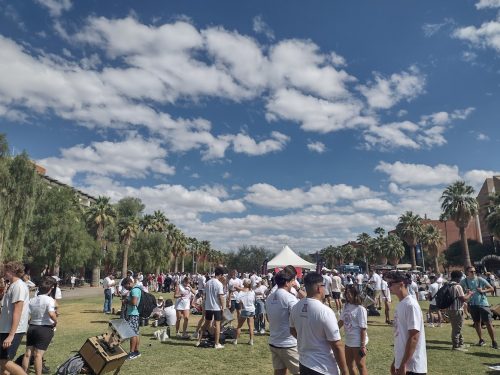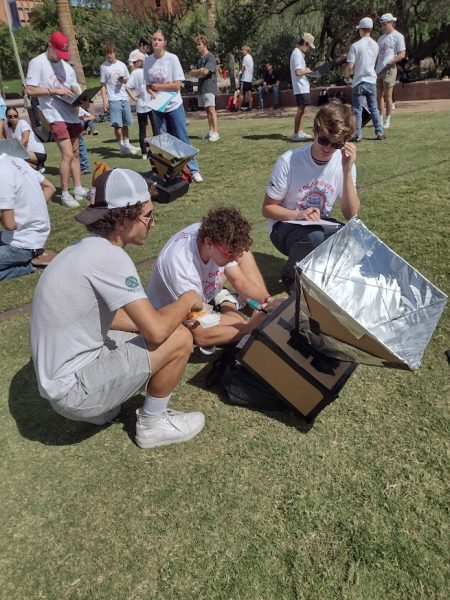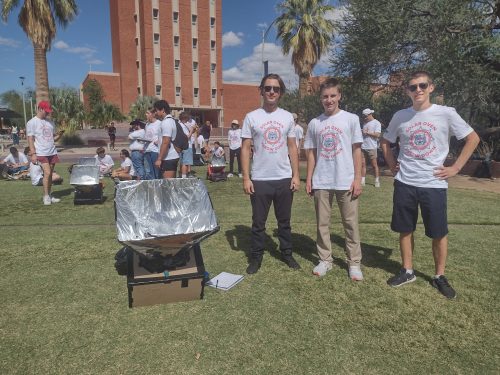Lindsey Ray Johnson, El Indie Arizona

A sea of students wearing white t-shirts flooded the mall at the University of Arizona on Oct. 12 for the College of Engineering‘s Solar Oven Throw Down.
Around 650 first-year engineering students came together to test the solar ovens they had spent the past month making in their beginning engineering classes.
Paired into groups of four, the students come from different classes with different instructors, but the assignment was the same: To bake a store-bought biscuit.

There was not requirement that the biscuit be edible and several students, when asked if they would eat the biscuits after they’ve baked in the ovens, responded with a definite, “no.”
Megan Bedinger said careful planning and calculation went into building their ovens to keep them within the required guidelines and be creative.
“There are a lot of variables that we can change, the box size, the length of the reflectors window and the type of insulation you have,” Bedinger said. “Basically, the ratio of the length of the reflectors to the window is one of the biggest factors.”
Bedinger said students were given cardboard, mylar and $20 to build their oven.
Engineering student Hunter Kernan described the process that went into building the solar oven.
“It was a lot of planning, a lot of calculations. We used Excel to predict our temperature using a formula,” he said. “And from there we used that to design the most efficient oven possible.”
“Right now, we are shooting for 180 degrees Celsius,” he added. “We are hoping to get around there, and I know some ovens here will probably be shooting for around 200.”
Kernan, said the oven projects will be graded, and part of that grade is based on how close their oven gets to the predicted temperature.
“It was a lot of building” he said. “We built a prototype, tested it and built a second prototype and that’s what we are testing now and we are hoping for a better temperature.”
Aside from the carefully crafted ovens, weather also played a role in the throw down.
“Our biggest fears are clouds coming over and blocking the sun, which has already happened a couple of times. What we want is clear skies and good sunlight going straight into our oven,” Kernan said “We just want good sun and hopefully that is what we get for most of the experiment, but today has been a little cloudy.”

UA engineering professor Steve Larimore is in charge of the Engineering Capstone Design Program, “which is basically the senior equivalent of this event,” he said.
“What happens is when you get to my class, you have a real engineering project, typically sponsored by some company, and they want a real product,” he said.
Larimore said he thinks that events like the throw down are essential for engineering freshmen.
“It gets them started, it gets them hands on, it gets them used to working in a team,” he said.
“It’s progressive; they grow line upon line,” Larimore said. “They learn the basics of engineering and along the way learn all the different aspects of engineering so that when they get there they are able to actually be successful.”
After an hour in the sun, the throw down was done and the faint smell of biscuits was in the air.
“Our biscuit did ‘cook’ to some degree,” Kernan said. “Although it was still mushy and runny. It certainly wasn’t cooked to the extent we were hoping for, but there was some hardening.”
“Our temperature reached a maximum of 74 degrees Celsius. This was a rather low temperature and was certainly an outlier when compared to the average temperature of most people’s ovens,” Kernan said, adding that some ovens reached more than 250 degrees Celsius. “Our oven was flawed in ways that we didn’t foresee and our results suffered as a result.”
Kernan said dissecting why the oven failed will be a large part of his final report.
El Inde Arizona is a news service of the University of Arizona School of Journalism.
